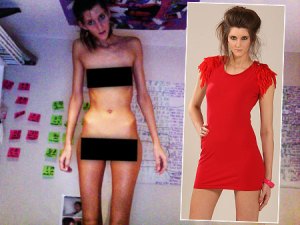A lot of dieters and eating disordered people experience a great deal of success, while enjoying the flexibility of the Up Day Down Day diet (also called UDDD on many discussion forums, weight loss sites, and ED websites as well. The diet was was developed by James Johnson, M.D., and I fear the fact that it was created and is promoted by a real doctor gives this diet the appearance of being medically sound advice. I personally think this is a diet that can push the average dieter from normal eating into the endless abyss of an eating disorder, and I would actually call this the Absolute EDNOS Diet, if I was to rename it! Using the calculator on the website, you enter your age, height and weight stats and select a weight loss program, and the automated program calculates the total calories you need for your “Up Days” and your “Down Days.” Then you alternate between these two totals.
I’m sure the doctor adds extra advice, tips and even diet supplements to help people, but must admit I did not read beyond the basic instructions of alternate between Up Day and Down Day calorie totals until you change to a weight maintenance program when you’re satisfied with the results. I put in my own stats, and after calculating for the 20% weight loss program with little or no exercise, I am given 1381 calories on the Up Day and 276 calories for the down day. You are advised to only weigh every other day, after a Down Day, so that the Up Day fluctuations don’t freak you out.
I can honestly say that I have never tried this diet because I am terrified of the Up Day total. I am perfectly comfortable with the Down Day total–and just made a mental note that I should aim to only exceed this total two days of the week, because I’m disordered and this seems to be the perfect number to me now that a computer has actually recommended it for me. I hope you can see how this is, in my opinion, one of the most dangerous diets promoted on the web today. I think if you don’t have an eating disorder yet, but you are so desperate to lose weight that you give this Up Day Down Day diet a try, within a month your head will be twisted up in calorie counts for every speck of food that you look at: an endless hell of mental calculations and keeping a running total in the back of your head all day long. With these numbers floating in your thoughts, arguing with your growing hunger pangs, you are not able to pay as close attention to your work, personal conversations, or even your surroundings because you’ll be caught up in your own head space, adding and subtracting food totals as you imagine eating them. By the end of the day, you may even find you haven’t eaten a thing because you couldn’t decide between 50 calories of cherries or 50 calories of fat free yogurt, so you had zero calories of anything. At least, that’s how it tends to go for me.
I do not recommend the Up Day Down Day diet to anyone, but I would be interested in hearing how it works for those who are actually happy with it. Did you have an eating disorder before you tried this diet? Did you consider the diet safer than others because it’s created and promoted by a real doctor? Did you lose weight and enjoy the diet, finding it easy to follow? Do you have an eating disorder now that you have used the diet?



















